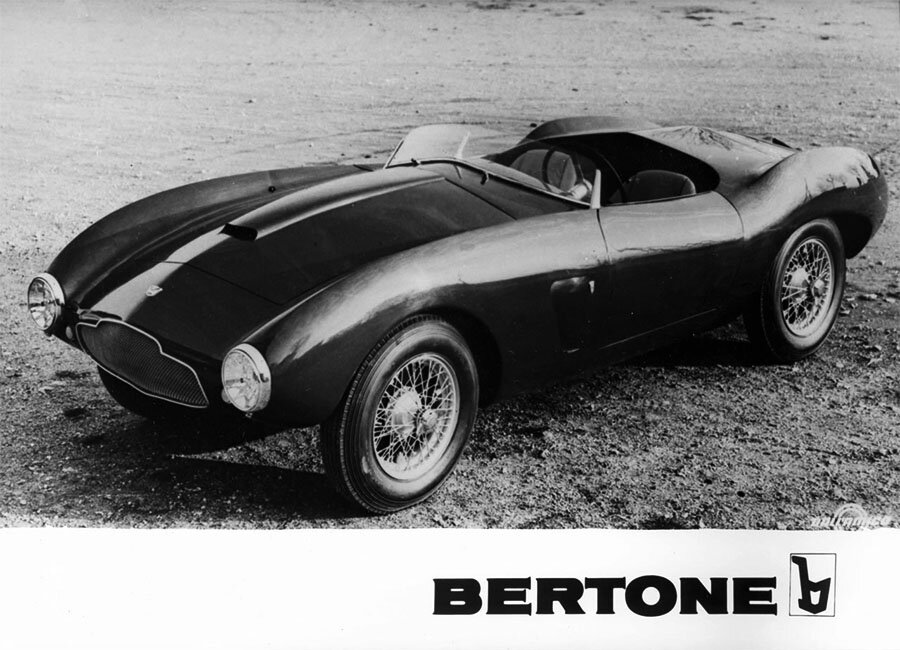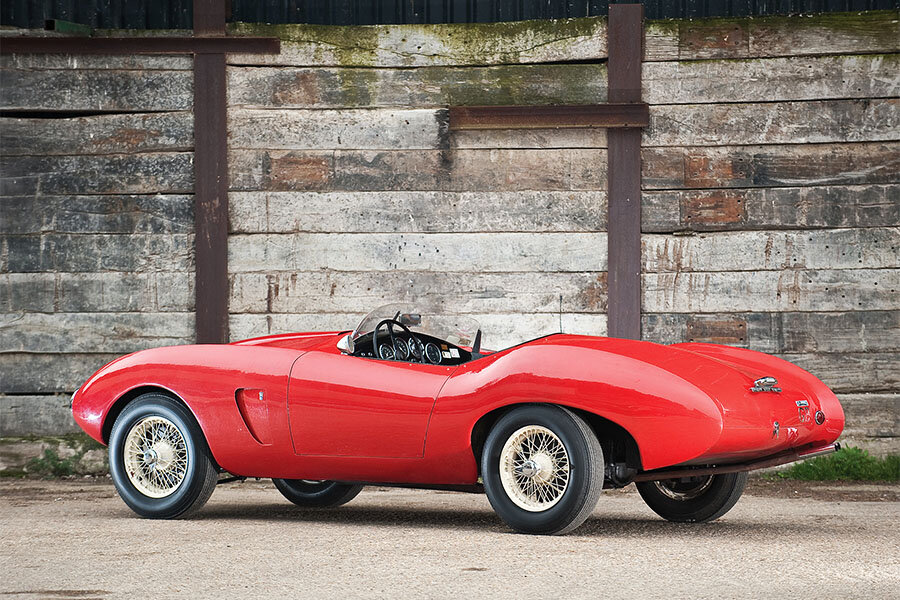Guide: Aston Martin DB2/4 Bertone - a Historical & Technical Appraisal
/BACKGROUND
Stanley Arnolt was a millionaire Chicago industrialist who owned a wide range of manufacturing businesses. During the early 1950s, Arnolt also became a distributor for a variety of British motor cars to include Rolls Royce, Bentley, Bristol, MG and Aston Martin.
Another of Arnolt’s automotive holdings was a stake in Carrozzeria Bertone. The tie up came about after Arnolt and Nuccio Bertone met at the 1952 Turin Motor Show (April 23rd to May 4th). Arnolt wanted to begin manufacturing cars under his own name and duly became a Director of the cash-strapped coachbuilder.
Arnolt wasted no time using his connections with British manufacturers to have naked chassis sent from England to Italy where they were clothed with exciting Bertone bodies.
First to arrive was the 1953 Arnolt MG which was based on the MG TD. 200 were ordered.
That year, Bentley dispatched an R-type Continental chassis to Turin where it was fitted with a Bertone body for Arnolt’s personal use.
Towards the end of 1953, Arnolt convinced David Brown to send five of his new Aston Martin DB2/4s to Bertone. The quintet of sequentially numbered DB2/4s were then transformed into a trio of competition-style Spyders and a brace of luxurious Convertibles.
Aston Martin launched the DB2/4 at the London Motor Show in October 1953 as a replacement for the critically acclaimed DB2.
CHASSIS
Unlike the DB2, which was a strict two-seater, the DB2/4 came with two occasional back seats and a lift up rear hatch.
The new car underwent a subtle cosmetic redesign but retained the well-proven underpinnings of the original model. This included the DB2’s rectangular steel-tube chassis although, for this latest application, the cross bracing over the rear axle had been removed to allow space for the rear seats.
Independent front suspension was via coil springs and trailing arms with hydraulic Armstrong shocks and an anti-roll bar. At the rear was a live axle located on each side by a pair of parallel radius arms and a transverse Panhard rod.
Hydraulic 12-inch drum brakes were supplied by Girling.
16 x 5.75-inch wire wheels were offered with both Dunlop and Avon tyres.
To free up space, the DB2’s 19-gallon fuel tank was reduced to 17-gallons and mounted lower in the chassis than before.
ENGINE / TRANSMISSION
The DB2/4 retained the extraordinarily smooth DOHC straight six of its predecessor which was now available in two alternative states of tune. Both types featured a cast-iron block and a light alloy head with two valves per cylinder.
The VB6E unit was the same as the Vantage engine from the outgoing DB2. It displaced 2580cc thanks to a bore and stroke of 78mm and 90mm respectively. Compression was 8.16:1 and two 1.5-inch SU sidedraught carburettors were fitted. Peak output was 125bhp at 5000rpm and 144lb-ft at 2400rpm.
The VB6J was bored from 78mm to 83mm for a cubic capacity of 2922cc. It retained the same 8.16:1 compression as the 2.6-litre motor but now came with bigger 1 ¾-inch SU carbs. Peak output was 140bhp at 5000rpm and 178lb-ft at 3000rpm.
Aston Martin offered the VB6J engine in the fixed-head DB2 from October 1953 but Convertible buyers had to wait until April 1954 to get their hands on the 140bhp unit.
Transmission was via a David Brown four-speed manual gearbox with synchromesh on second, third and fourth. A single-plate clutch was fitted.
BERTONE SPYDERS
DB2/4 chassis numbers began at LML/501.
Arnolt’s three odd-numbered chassis dispatched to Italy were clothed as Spyders to a design by Franco Scaglione. They were fitted with the VB6J 2.9-litre 140bhp engines and rank among the most beautiful Aston Martins of all time.
Chassis LML/503 and LML/507 were competition-style roadsters while LML/505 was slightly more luxuriously equipped. All three wore steel bodies (as did the two Convertibles).
The Spyders featured exposed headlights either side of trademark Aston Martin-shaped nose intakes complete with meshed grilles. The fenders, hoods and trunks were elegantly creased. Intake scoops were added to the front lid. Cooling vents were carved out from behind each front wheel.
Cockpits were minimalist with metal dash fascias and bucket seats. None of the three cars had any side windows.
The competition-style roadsters (LML/503 and LML/507) were completed with lightweight trim and painted red. Each came with a cut-down windscreen, inboard tail lights, rubber floor mats and no bumpers. A simple dash housed all the instrumentation centrally.
LML/503 was retained by Stanley Arnolt for most of his life while chassis LML/507 was sold to one of Arnolt’s racing team drivers, Phil Stewart. Prior to Stewart’s ownership, LML/507 had been displayed at the Chicago Motor Show in February 1954.
The other Spyder (LML/505) came with Deluxe trim and was painted blue. It featured a full height windscreen, folding canvas roof, quarter bumpers at the front, a full width bumper at the rear and tail lights mounted on the rear fenders (as opposed to having been inset like LML/503 and LML/507). Vertical bumperettes were added within the subtly re-shaped primary intake.
LML/505 also came with a more luxurious interior (but still no side windows). A new dash layout clustered the three main gauges directly behind the steering wheel in a custom binnacle. There was also an open glovebox with passenger grab handle. The floors were carpeted and higher quality door panels were fitted.
LML/505 was bought new at the New York Motor Show in April 1954 by a Mr Schwaumbauer of Wichita, Kansas.
BERTONE CONVERTIBLES
In addition to the trio of Spyders, Bertone also produced two handsome Convertibles on Arnolt’s pair of even numbered chassis (LML/504 and LML/506). These cars were more conventionally styled by Giovanni Michelotti and came with all the amenities expected of a luxury Gran Turismo. They were fitted with VB6E 2.6-litre 125bhp engines.
Exposed headlights were mounted either side of a large nose intake that housed a five bar grille. Full width bumpers with overriders were fitted at either end.
Both examples came with a shallow hood-mounted engine intake and en elegant front fender vent that was accessorised with an elaborate chrome trim.
When lowered, the folding canvas roof stowed below a tonneau that was almost flush with the rear deck.
Rear fenders were subtly finned.
Interiors were equipped with well-padded seats suitable for long-distance touring. Leather was used to upholster the seats, door panels and the sides of the rear quarters.
Dashboards were body coloured metal and had the three gauges located directly behind the three-spoke steering wheel.
Inevitably, there were several minor differences between the two cars.
LML/504 (painted red) came with slim bumpers, a front grille with inset spot lights, low-finned rear fenders and a chromed engine intake on the hood. Inside, an extra seat was installed behind the passenger while the area behind the driver was a dedicated zone for a custom set of luggage.
LML/504 also came with a monogrammed horn for its first owner, Charles Ward of Saint Paul, Minnesota.
LML/506 (painted blue) came with thicker front bumpers, no spot lights, high-finned rear fenders, an exposed fuel filler cap and two seat interior. It was sold to Edith Field of San Francisco.
WEIGHT / PERFORMANCE
Aston Martin quoted a weight of 1195kg for the standard DB2/4 so it would be safe to assume the two Bertone Convertibles were broadly similar while the Spiders would have been a little lighter.
SUBSEQUENT EXAMPLES - INDIANA CONVERTIBLE
After just over half of the 200 MG TD chassis ordered by Arnolt had been delivered to Italy, MG informed their client that they were unable to supply any more owing to high demand for complete cars. Arnolt began to look for a new supplier and negotiated with Bristol for 200 of their 404 series chassis.
While Aston Martin had been reluctant to provide any further chassis to Arnolt, two more DB2/4s did find their way to Italy during 1954. Both received coachwork styled by Franco Scaglione. By this time, the DB2/4 Mk2 had been introduced and the 2.9-litre 140bhp VB6J engine was standard.
The first chassis was LML/762 which Bertone built as a grey two-seat Convertible dubbed the Indiana which Stanley Arnolt retained for his personal use. Completed in late 1954, LML/762 featured an intricately contoured front end with exposed headlights and trademark Aston Martin-shaped primary intake with egg-crate grille. Bertone added a wraparound windscreen, a sloping tail with finned rear fenders, full width bumpers and a canvas roof that, when lowered, disappeared almost completely from view.
The properly trimmed interior came with well-cushioned seats and a custom dash with black vinyl top and body coloured metal fascia. Instrumentation was housed in a curvaceous binnacle directly behind the steering wheel.
Upon completion LML/762 was displayed at the Paris Motor Show in October 1954. It was subsequently presented at the New York Motor Show in April 1955.
SUBSEQUENT EXAMPLES - COUPE
Chassis LML/765 was the last of the seven Bertone DB2/4s and the only example completed as a Coupe. It was commissioned as a prototype for a potential run of 100 cars but David Brown subsequently refused to supply Arnolt with any more unclothed chassis.
LML/765 was equipped with exposed headlights, a unique slatted grille, wheelarches with swept back peaks and a fastback cabin with wraparound windscreens at either end. The back was home to vertical fins, a staggered tail and a full width bumper. Quarter bumpers were fitted at the front.
The two-seat cockpit was to the latest specification with all the instrumentation housed in a modern semi elliptical binnacle. The dash top and binnacle were upholstered in black vinyl and all the switchgear was located along a slim full width metal fascia.
LML/765 was sold to Henry Pagezy of Paris in 1955. Bertone later borrowed the car for their stand at the 1957 Turin Motor Show.
LATER BERTONE ASTON MARTINS
Bertone did go on to clothe one more Aston Martin in period when David Brown sent the last DB4 GT to Italy for coachwork.
The resulting Bertone Jet displayed at the Geneva Motor Show in March 1961 was another design masterpiece.
Text copyright: Supercar Nostalgia
Photo copyright: Bertone - https://www.bertone.it , Gooding & Co. - https://www.goodingco.com/ & Woodham Mortimer - https://woodham-mortimer.com/








































